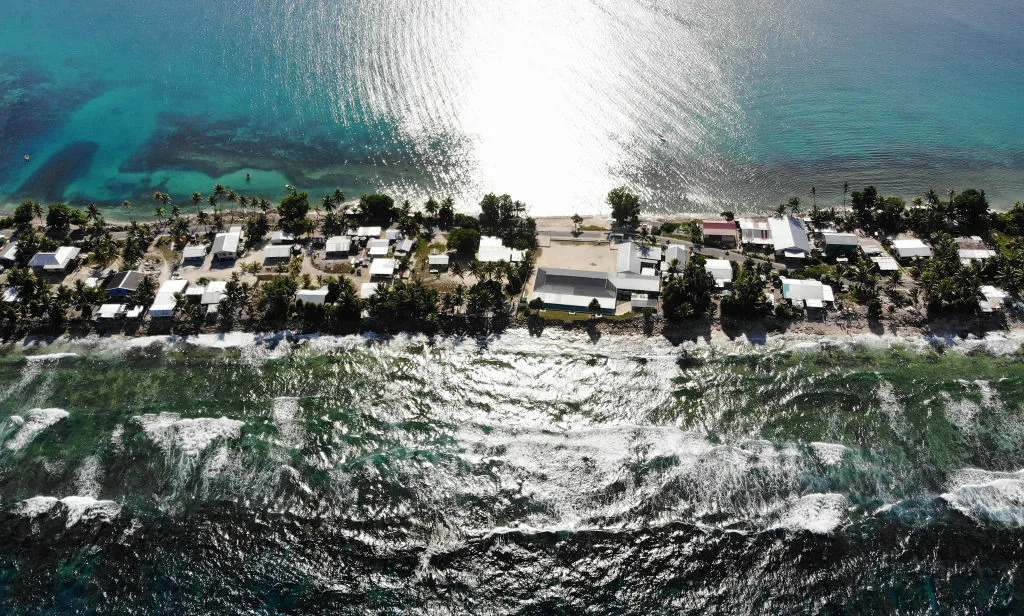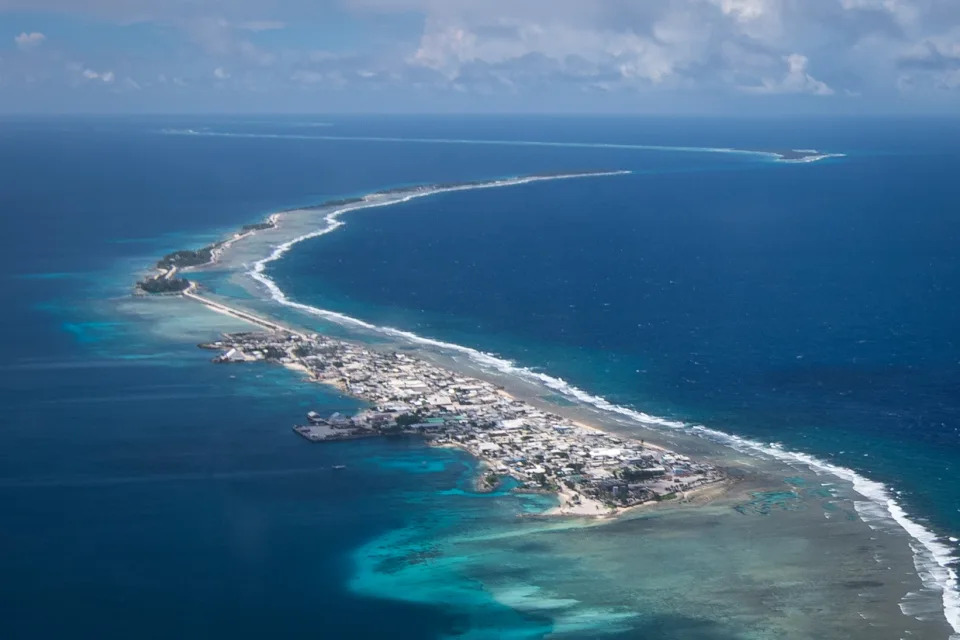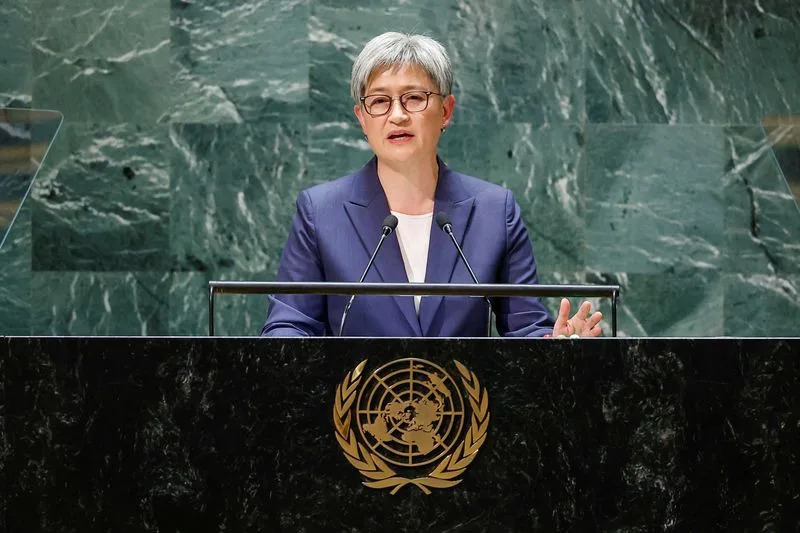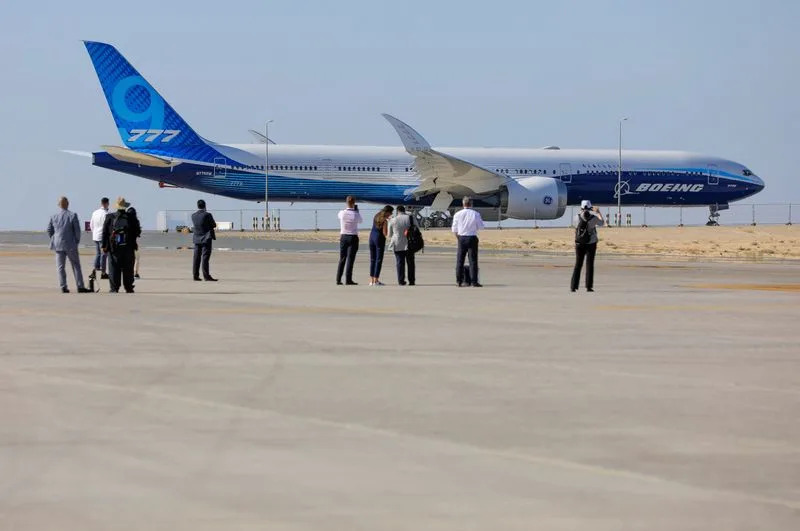‘Bad actors’ used state program to
store pallets, hand sanitizer under
10 Fwy. before arsonist struck,
Newsom says
This weekend, a large fire damaged the 10 Freeway in Los Angeles, shutting down a primary transportation route for hundreds of thousands of people.
State Fire Marshal Daniel Berlant said investigators “have been able to confidently determine” that the blaze was caused by arson, though the person or persons involved have not been identified.
The investigation is ongoing into “what we believe to be malicious and willful intent of starting a fire,” Berlant said.
But how did those flammable materials end up under the freeway? It’s part of a government program that leases that space to private citizens and companies.
Caltrans’ Airspace and Telecommunications Licensing Program — often called simply Airspace — “is responsible for leasing and managing those properties or sites held for a transportation purpose that can safely accommodate a secondary use,” the agency said on its website.
“More simply put, Airspace leases specific areas within state highway right of way,” Caltrans added.
Federal authorization is also required before a lessee can be approved, according to Gov. Gavin Newsom.
In this case, the space was being leased to a company called Apex Development Inc., though the lease has expired and that entity is involved in litigation with the state. Newsom expects the case to be heard in court in early 2024.
“This guy and this organization, whoever the members of that particular organization are, have been bad actors,” Newsom said. “We’ve been in a litigious posture for some time. They stopped paying their rent, they’re out of compliance, and as was stated yesterday … they have been subleasing this site to at least five, maybe as many as six tenants, without authorization from Caltrans or authorization from our federal partners.”
While that investigation is ongoing, appraisals into what will be needed to reopen the roadway showed some positive signs, Newsom said Monday afternoon.
“The structural integrity of the deck appears to be much stronger than originally assessed,” Newsom said. “That does not mean that we are moving forward without consideration of a demo[lition]. Quite the contrary. We are assessing additional samples, but the preliminary samples show more positive results than initially anticipated.”
A potential window for reopening has not yet been determined.
LOS ANGELES (AP) — Arson was the cause of a massive weekend fire that charred and indefinitely closed a vital section of a Los Angeles freeway, causing major traffic headaches for hundreds of thousands of commuters, California authorities said Monday.
Gov. Gavin Newsom said investigators were trying to determine if one person or more were involved. He gave no other details.
“I have to stress that we have determined what started the fire,” Newsom told reporters.
The fire erupted Saturday in two storage lotsf under Interstate 10. Construction materials combusted quickly and the fire grew. It left many columns charred and chipped and the deck guardrails twisted. Crews shored up the most damaged section for the safety of workers clearing the debris. It’s still unclear what structural damage, if any, the blaze caused to the freeway.
Beyond a massive traffic headache, the closure is expected to be felt well beyond the metropolis, including possibly slowing the transport of goods from the twin ports of LA and Long Beach, federal officials have said. The ports handle more than half the goods coming into the country. President Joe Biden had been briefed on the fire.
“It’s disrupting in every way, whether you are talking about traveling to and from work or your child care plans and the flow of goods and commerce, this will disrupt the lives of Angelenos,” LA Mayor Karen Bass said.
Los Angeles residents were urged to avoid travel to the area Monday and to work from home if possible.
“Our streets cannot handle 300,000 cars,” Bass said, referring to how many vehicles use the I-10 stretch daily.
Officials have said the damage is reminiscent of the 1994 Northridge earthquake that flattened thoroughfares. After the quake, it took more than two months to repair Interstate 10 — and that was considered significantly fast.
Newsom said early tests show that the deck “appears to be much stronger than originally assessed." Concrete and rebar samples taken Monday from the superstructure, decks and columns will help determine “whether or not we’re tearing this down and replacing it, or we’re continuing the recovery and repairs,” he said.
“This isn’t going to be resolved in a couple of days, and it’s not going to take a couple years," Federal Highway Administrator Shailen Bhatt told The Associated Press. "But whether it’s weeks or months, we’re still too early to tell.”
Bhatt said the fiery June 11 crash of a tractor-trailer hauling gasoline in Philadelphia that collapsed an elevated section of Interstate 95, snarling traffic and hurting area businesses, highlights the impact of such disasters not only on a city but on the nation.
“The ports are still open and the goods will still flow, but when you remove a section of the interstate that carries 300,000 vehicles a day, there’s going to be spillover impacts,” Bhatt said. “The concern there is the quicker we can get this open, the faster we can remove an impediment.”
Drivers were tested Monday during the first weekday commute since the raging fire. Some freeway exits backed up as drivers were forced to use crowded surface streets to bypass the damaged freeway stretch south of downtown.
Some routes, however, had lighter traffic, suggesting drivers heeded warnings from the city to make alternate plans. Cellphones blasted Monday with a predawn reminder for residents to plan different routes or expect significant delays.
“Our businesses are just bouncing back from the Covid shutdowns. Business was just getting good,” said Blair Besten, director of LA’s Historic Core business improvement district. She's worried about the lingering effects of this closure.
Flames reported around 12:20 a.m. Saturday ripped through two storage lots in an industrial area beneath I-10, burning parked cars, stacks of wooden pallets and support poles for high-tension power lines, city fire Chief Kristin Crowley said. No injuries were reported.
At least 16 homeless people, including a pregnant woman, living underneath the freeway were brought to shelters. More than 160 firefighters responded to the blaze, which spread across 8 acres (3 hectares) and burned for three hours.
California Fire Marshal Daniel Berlant said investigators have identified where the fire started and what the cause was after sorting through the rubble for evidence but did not specify what they found. He said there is no suspect information yet. He said they are talking to witnesses, including homeless people and nearby business owners.
Storage yards under highways are common statewide, with the money from the leases going to public transit. Newsom said the practice would be reevaluated following the fire.
The governor said California has been in litigation with Apex Development, Inc., the owner of the business leasing the storage property where the fire started. The lease is expired, Newsom said, and the business had been in arrears while illegally subleasing the space to five or six other entities. “They’ve been out of compliance for some time, that’s why we’re going to court” early next year, he said.
Mainak D’Attaray, an attorney for Apex Development, confirmed the company was in litigation with the state.
“We are currently investigating ourselves what happened at the yard under the freeway. As such, we are not prepared to give an official statement or answer questions until we have determined what actually occurred,” D’Attaray said in an email.
Ertugrul Taciroglu, chair of the civil and environmental engineering department at the University of California, Los Angeles, said part of the challenge is how expensive real estate has become.
“Every piece of land is being utilized, so I can see the pressure or the incentives for making use of these spaces under these highways,” he said.
Two contractors have been hired to clean up the hazardous material and to shore up the freeway, according to California Secretary of Transportation Toks Omishakin.
Repairs will require environmental waivers and federal funding, officials said.
In 2011, a fire from a poorly maintained fuel tanker that burst into flames damaged a stretch of State Route 60 — a key freeway connecting LA with its eastern suburbs — and took six months to reopen at a cost of $40 million.
The city and county of Los Angeles in 2020 agreed to provide housing for almost 7,000 people living under freeways and near exit and entrance ramps. In approving the deal, a federal judge said unhoused residents in those areas face particularly deadly hazards.
_____
Watson reported from San Diego. Associated Press writer Christopher Weber in Los Angeles contributed to this report. McMurray reported from Chicago.
Nathan Solis, Ruben Vives, Richard Winton, Brennon Dixson, Ashley Ahn
Mon, November 13, 2023
The massive fire that has shut down a crucial section of the 10 Freeway in downtown Los Angeles was caused by arson, officials said Monday as they raced to assess the extent of the damage and determine how long it would take to reopen.
More than 100 columns along the swath of the freeway were damaged — nine or 10 of them severely — Gov. Gavin Newsom said.
It's still unclear, pending the results of official tests at the site, if the entire overpass will be torn down or retrofitted.
The situation poses a commuting challenge that L.A. has not seen in years, with hundreds of thousands of commuters facing detours and heavier-than-normal traffic. Starting Monday, some worked from home and others took mass transit, but many simply endured the delays.
The closure caused gridlock in some areas, but there was general sentiment that L.A. survived the first morning and evening commute without too much chaos thanks in part to warnings sent to residents' cellphones.
The fire began under the overpass at Alameda Street early Saturday morning, fueled by wood pallets stored there.
Although the exact cause of the fire has not been revealed, "there was [malicious] intent," Newsom said at a news conference Monday afternoon.
In addition to pallets, sanitizer accumulated during the height of the COVID-19 pandemic was stored under the overpass and helped fuel the flames, according to sources familiar with the probe who were not authorized to discuss details of the investigation.
Read more: 10 Freeway closed: How to deal with the traffic nightmare in downtown L.A.
State Fire Marshal Daniel Berlant appealed for witnesses to call a tip line with information and noted those tips could be given anonymously.
"We have identified the point of origin of the fire," Berlant said. He would not provide further detail, saying the investigation was ongoing. Berlant said investigators had dug through the rubble for evidence and canvassed the neighborhood for witnesses.
Officials said the property where the fire broke out was being leased by Calabasas-based Apex Development Inc., which was subleasing the storage site under the overpass without permission from state and federal agencies. The company stopped paying rent, according to Newsom, and had been out of compliance with its lease agreement.
Federal, state and local agencies are scrambling to determine what happens next after the sudden closure of the mile-long section of the heavily trafficked freeway between Alameda Street and the East L.A interchange, a key east-west route through downtown. Mayor Karen Bass said that U.S. Secretary of Transportation Pete Buttigieg called and reassured her that federal officials were aware of the impact from closing one of the busiest freeway corridors in the country.
"Losing the stretch of the 10 Freeway will take time and money from people's lives and businesses," Bass said. "It's disrupting in every way. Whether you were talking about traveling to and from work, or your child care plans, and the flow of goods and commerce, this will disrupt the lives of Angelenos."
Mitigation of hazardous materials at the site is ongoing, but most of the site has been cleared for structural engineers and maintenance crews to start their work, California Transportation Secretary Toks Omishakin said. They have taken samples of the freeway columns and bridge deck.
An initial influx of federal emergency funds has been secured, said Tony Tavares, director of the California Department of Transportation. Contractors have installed shoring underneath the overpass and in the most heavily damaged areas. Video footage from the scene shows the charred underbelly of the overpass and what appear to be sections of columns chipped away.
The fire was reported early Saturday, shortly after midnight, in the 1700 block of East 14th Street after a pallet yard under the freeway caught fire and spread to a second pallet yard, damaging the freeway overpass and destroying several vehicles, including a firetruck, authorities said.
Timothy Garrison, 55, was sleeping behind a nearby Shell gas station near the overpass when he heard explosions, he said Monday morning as he sat against a wall near 14th and Elwood streets, around the corner from the site of the fire.
When he peeked out of his makeshift tent made of plastic trash bags, he saw giant flames flickering out of the overpass.
“The heat was so intense,” he said. “I thought the overpass was going to crumble.”
Garrison heard about 10 to 15 pops and explosions as the fire continued to rage, and he moved to escape the heat, he said.
He knew of some people who lived underneath the freeway but said he had not seen them.
Bass said 16 people were living in the encampment, and all had been moved into hotels and motels.
A row of blue tarps, trailers and wooden shacks sat along 14th Street on Monday among piles of wood from pallets and metal debris. Wooden pallet yards are common along the 10 Freeway in the industrial center near downtown.
Not far from Santa Clara Street, a group of men had set cardboard and wood on fire to cook several feet from a pallet yard.
CalFire officials said they were taking all elements into consideration in their investigation, including the presence of homeless people in the area. But on Monday afternoon, Bass said there was "no reason to assume the reason this fire happened was because there were unhoused individuals nearby."
Read more: Rain is coming to Southern California: How much and when?
Workers in the area said firefighters frequently come to put out fires caused by people living on the streets.
It's why Antolín Padilla, 34, installed fire extinguishers at the entrances of his business Jaz Pallets, which sits along the railroad tracks near Santa Clara Street. He and another pallet yard owner on 14th Street agreed to enforce a "no camping zone" around their businesses, often telling people to camp elsewhere, after a fire spread to the wall of Padilla’s pallet yard a few months ago.
“The workers grabbed the extinguishers in time and were able to put it out,” he said, pointing to a charred corner of the wall. “The city needs to move people from this area.”
Nearby, David Cortez, 34, owner of D&G Pallets, said the fire shows why he’s often on edge.
Standing outside his business, he pointed to a pole where a thin green wire dangled from the power line above, saying he worried about homeless people tampering with lines to tap into the electricity.
“I’m not even sure if that wire is energized or not, but it’s dangerous,” he said. “And the fire hydrants have been damaged from people attempting to use pliers to get water.”
Derrick Smith, 39, walked nearby pushing a cart filled with metal debris. He had been staying near the overpass when the fire broke out. At least five or six people were living around him, he said.
Smith said he was in a deep sleep when he started to hear people banging on his trailer to warn him of the fire.
“They kept saying there’s a fire and get out,” he said. He ran away, leaving all his belongs behind.
“The heat was intense as hell,” he said.
Wearing a blue hoodie, black shorts and dirty Crocs, he said he had no change of clothes and is not sure whether he lost his trailer.
“I probably did,” he said, stuffing his hands in the pockets of his sweater.
Monday's commute was the first weekday for Angelenos encountering the disruption. The mayor's office sent an emergency advisory Sunday evening alerting residents about the detour, and officials encouraged employers to let their employees work remotely if possible. Nearby L.A. Unified schools remained open, though traffic was expected to be worse, especially in Boyle Heights and south of downtown.
At Grand Central Market, Maria Behringer scrambled Monday to set up the pastries for Bastion Bakery after she left her apartment near USC around 6:40 a.m. and arrived around 7:15 a.m. Though the market opens at 8 a.m., she needed time to set up her station before customers started trickling in.
“I was definitely rushing more than I usually do, so it was little a bit of a stressor,” said Behringer, 30. “I didn’t realize how close the fire was to downtown and I didn’t realize it would affect my commute.”
Her partner, Brandon Walsh, who rode in with her, said their usual commute takes them east on the 10 and then onto the 110 Freeway. But this time, the GPS rerouted them to side streets.
“I think so much was diverted to 110 [because of the fire] so the GPS just told us to get off at Grand and go into the city,” said Walsh, 32.
Officials encouraged car commuters to try alternatives, such as Metrolink, rail lines and local bus services, which are all expecting an increase in daily riders.
Metro Chief Executive Stephanie Wiggins told Angelenos to "plan ahead, share the ride, and keep up to date" on the disruption. She said there was a noticeable increase in cars parked at Union Station on Sunday, indicating people are taking advantage of public transportation. Officials directed drivers to check the detour status online at emergency.lacity.gov, and commuters can call 511 or check Metro.net for alternative routes.
"This is our litmus test," Omishakin said Monday. "Did we reach everyone and convince them that they need to plan ahead and plan alternate routes?"
At Union Station, Metro ambassadors said foot traffic was lighter than usual.
Brian Lin, 45, of Anaheim was sitting in heavy traffic on the 5 Freeway when he decided to park his car at Atlantic station in East Los Angeles and take the train into Union Station.
He admitted he doesn’t typically take the train to work, but Monday’s congestion called for a change — at least for one day.
“Luckily, it was just a quick meeting that I had to do in the office,” Lin said before an incoming Metro train chimed in the distance. “I think my ride is here.”
Claire Stolwyk, 27, waited for the J line bus at the Civic Center/Grand Park station while reading a book when she realized she had forgotten to check whether her commute to Cal State L.A. would be affected.
She pulled out her phone and saw a notice from Metro on Google Maps, but it looked like her route was in the clear. The bus pulled up to the stop on time.
Daniel Miller, Andrew Khouri
Sun, November 12, 2023
The 10 Freeway in downtown Los Angeles will remain closed indefinitely as the California Department of Transportation moves to repair an overpass badly damaged by an intense fire early Saturday at two storage yards in an area with multiple homeless encampments.
The incident, which closed westbound and eastbound lanes of the busy freeway between Alameda Street and Santa Fe Avenue, will significantly affect traffic in the area, officials said at a news conference Sunday, without offering a timetable for reopening.
“Unfortunately, there is no reason to think that this is going to be over in a couple of days,” L.A. Mayor Karen Bass said. "We will need to come together and all cooperate until the freeway is rebuilt."
Gov. Gavin Newsom declared a state of emergency Saturday to help expedite the work. Acknowledging "the anxiety of millions and millions that live in this region," Newsom noted that 300,000 vehicles travel through the freeway corridor daily. And he said he knew the question many are asking: "When the hell is this going to get reopened?"

Gov. Gavin Newsom, left, and Los Angeles Mayor Karen Bass attend a news conference Sunday at Caltrans headquarters in downtown Los Angeles. (Francine Orr / Los Angeles Times)
Several things must occur before construction can begin — starting with an investigation into the cause of the fire. It is expected to be finished by 6 a.m. Monday. Mitigation of hazardous materials also needs to be completed before a detailed structural analysis of the damaged portions of the freeway can commence. Engineers will be inspecting the freeway's columns and bridge deck.
"I am not going to understate the challenge here — it is significant," California Transportation Secretary Toks Omishakin said. "This is not going to be an easy task for our structural engineers at Caltrans."
Commuters were encouraged to take alternate routes, avoid the area altogether or use public transit to help ease traffic flow through the downtown area as work on the freeway continues.
This could be the most notable freeway closure in the Southland since the 1994 Northridge earthquake buckled portions of the 10 and other routes. The shutdown is expected to increase congestion on adjacent freeways where traffic is being diverted, among them the 5, 110 and 710.

Los Angeles firefighters continue to assess the damage from a fire under the 10 Freeway near downtown Los Angeles. (Francine Orr / Los Angeles Times)
The faint scent of smoke hung in the air Sunday morning as Caltrans workers examined a stretch of the freeway near 14th Street. Black marks were visible on the overpass where the Los Angeles City Fire Department responded to a reported rubbish fire at 12:22 a.m. a day earlier. The department said its first responders arrived to find a storage yard with pallets, trailers and vehicles "well involved in fire."
Ultimately, firefighters from 26 companies and one helicopter responded to the scene; they were able to keep the blaze from spreading into nearby structures, though a firetruck was badly damage.
Newsom said officials are investigating whether anyone was living under the overpass at the time of the fire, but at the moment there are no known deaths from the incident. Bass said some homeless people living nearby evacuated because of the fire and that at least 16 have since been housed.
On X, the service formerly known as Twitter, users posted images that purportedly showed homeless encampments beneath the freeway at 14th Street. Newsom said that he and other officials cleaned up an encampment there in August 2022.
“I am intimately familiar with this site,” he said.
The incident could lead officials to study the safety of homeless encampments near freeways across the city. Pete Brown, a spokesman for L.A. City Councilman Kevin de León, whose district includes the site of the fire, said he believed the incident would "trigger a review" of such properties.
"We just want to make sure folks are as safe as possible," Brown said. "Nine freeways crisscross through [de León's] district."
Since January, Brown said, the councilman's office had conducted six "cleanup operations" of sites under the 10 Freeway that had moved 36 people into housing in the downtown area. Two of the visits were at the property where the fire occurred, he said.
The area around the burn site is home to many homeless encampments. A man named Enrique who has been living in his car near the now-damaged overpass for most of the last year said that he woke up early Saturday to police shouting for people to clear the area.
“They were big flames, higher than that building,” the 58-year-old said, pointing to a two-story structure on 14th Street.
Behind Enrique, who declined to give his last name, there was a series of makeshift dwellings. A woman walked out of one and wandered the streets with no pants or underwear.
Los Angeles Fire Department Chief Kristin M. Crowley said that “as for any of the encampments in that area, we do not have any direct correlation at this point as to if that’s where it did start or didn’t.”
“We are going to have to standby and wait for the active investigation to be completed,” she said.
Homeless encampments have been the source of fires under and around freeways up and down the West Coast in recent years. In July 2022, a major blaze struck an encampment underneath the 880 Freeway in Oakland, destroying vehicles, snarling traffic and requiring the work of 60 firefighters to extinguish it. And in March, a fire in Tacoma, Wash., broke out in a tent beneath the 5 Freeway, leaving one person dead.
The 14th Street property where the fire occurred Saturday is owned by Caltrans, a spokesman for the agency said. Newsom said that site had been leased to an entity he declined to name. But the lease is expired, the entity is in arrears and it has been cited by state investigators, Newsom said.
He added that the state is in litigation with the lessee and believes it has been subleasing the space.
Omishakin said it’s common practice across the country to lease space under freeways. “This is something that is going to be reevaluated from a safety standpoint,” he said, including what is allowed to be stored underneath overpasses.
Southern California is no stranger to freeway closures. Far from it.
Mudslides, wildfires and snow storms have routinely shut down portions of freeways, highways and state routes — but those closures often are quickly resolved. The 5 Freeway, for example, was briefly shut down along the Grapevine a dozen times from 2018 to 2022 due to snow, Caltrans said. Some natural disasters have caused notable problems: In 2018, Highway 23, which connects Pacific Coast Highway and the 101 Freeway, was closed for about six weeks starting in November after the Woolsey fire ripped through nearly 100,000 acres in the Santa Monica Mountains.
Man-made fires have also taken their toll on Southern California's freeways. In 2013, a tanker truck carrying 8,500 gallons of gasoline crashed and caught fire, severely damaging a tunnel connecting the 5 and 2 freeways in Elysian Valley north of downtown. The conflagration burned through almost three inches of concrete and caused chunks of it to fall from the tunnel walls, necessitating a $16.5-million repair. The work wasn't completed until January 2014.
But the biggest disruption to the freeway system occurred after the magnitude 6.7 earthquake struck L.A. on Jan. 17, 1994, killing dozens and causing tens of billions of dollars of property damage. Parts of one highway and six freeways, among them the 5 and the 10, were closed after the temblor collapsed overpasses and buckled roadways, The Times reported.
An accelerated construction effort — one spurred by round-the-clock work — led to reopenings ahead of schedule. In the case of the 10 Freeway, which saw two sections flattened by the quake, contractor C.C. Myers Inc. finished the project 74 days ahead of schedule, allowing it to reopen in April. The company had been offered a $200,000 bonus for every day the work was finished ahead of schedule, The Times reported.
Bass invoked that push on Sunday.
“For those of you that remember the 1994 Northridge earthquake, Caltrans worked around the clock to complete the emergency repairs to the freeways, and this structural damage calls for the same level of urgency and effort,” she said.
Newsom said the state is now determining whether to offer contractors incentives to finish repair work quickly.
“We are sober and mindful of the urgency to get this open,” Newsom said. “It is safety first, it’s speed second.”
This story originally appeared in Los Angeles Times.
Editing by David Gregorio)












